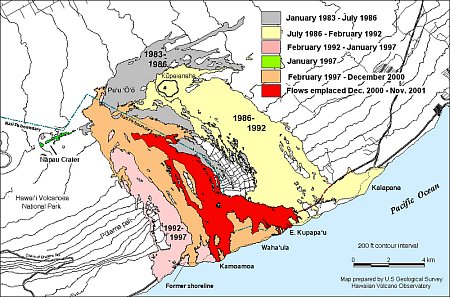
|
|
|
| Current Update | Update Archive | |
1 November 2001
New bench at Kupapa`u; Kamoamoa flow on Pulama pali
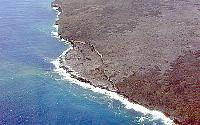 |
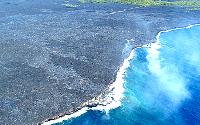 |
| Views of new bench at Kupapa`u entry. Left, new bench created in past 3-4 days, fed by broad flow nearly the same width as the bench. Right, new bench in foreground and old, but still active, East Kupapa`u bench in background. Image has been severely "pushed" for clarity. Inland from East Kupapa`u entry are access road and trail to viewing overlook above far end of bench. | |
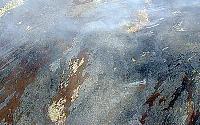 |
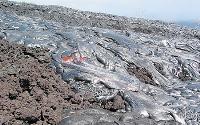 |
| Left, Smokey view of active Kamoamoa flow (shiny) on Pulama pali. Note that branches of the flow are on both sides of the ravaged kipuka. Right, lava in Kamoamoa flow moves down pali across slightly older `a`a and solidifies as pahoehoe. | |
|
Lava moving down Pulama pali east of the kipuka shown above, forming pahoehoe toes and tongues. Geologist stands on older pahoehoe unrelated to the active flow. |
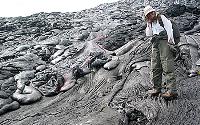 |
3 November 2001
Lava at dawn at Kamoamoa
|
0559. Thirty minutes earlier, this was a rushing lava cascade over the old sea cliff onto and below the surface of the bench at Kamoamoa. The cascade became roofed, and now, at 0559, only a small window shows that lava is still pouring down. Note the dripping roof of the tube, which is located right at the top of the old sea cliff about 50 m west of the formerly unstable point (see image below). |
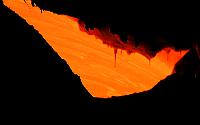 |
|
0639. Looking into the sun across the western part of the Kamoamoa bench, showing two areas where lava is pouring into the water. |
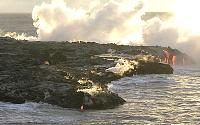 |
Some more comparisons showing bench growth
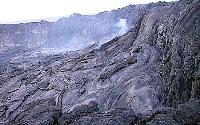
|
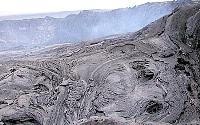 |
| Left: October 21. Right: November 3. Looking west. Both images from the same location. Note how the bench has thickened as a lava fan extends from the feeding tube to the water. The active--and probably the only--lava tube feeding the bench is coming over the old sea cliff in the upper right. Use points on cliff in distance to gage thickening of the bench. | |
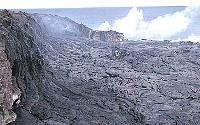
|
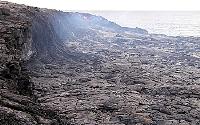 |
| Left: October 21. Right: November 3. Looking east along bench toward unstable point in background. Note the thickening of the bench and how much farther seaward it reaches. The unstable point, now stable because it is surrounded by the bench, has nearly been overtopped by November 3. Both images from approximately the same location. Note the skylight in the tube shown in the first image today (large view best). | |

|
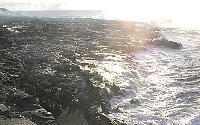 |
| Left: October 28. Right: November 3. Looking east from above west end of bench. Both images taken from nearly the same place only 6 days apart. The bench grew outward about 30 m during that time. The stepped skyline, nearly cropped out in November 3 view, is the area of the unstable point and has not changed significantly. Sorry about the sun. | |
7 November 2001
Scenes near Kupapa`u
|
View of eastern part of the new Kupapa`u bench, from the old sea cliff above the bench. In background is steam rising from the East Kupapa`u bench. Left of the steam is the visitor viewing area, best seen--though still faint--in large image. |
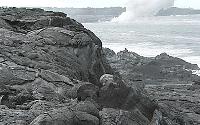 |
|
Lava breakout from inflating flow about 100 m inland from the new Kupapa`u ocean entry. Thin slabs of crust break up as the lava pours down the steep slope. The most active part of the breakout is 2-3 m wide. |
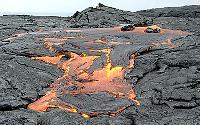 |
16 November 2001
|
Kamoamoa bench. Note the discolored water coming from the entry areas along the front of the bench. The main, or sole, tube feeding the bench is located in left part of the drapery on the old sea cliff, just right of center. White dots above cliff in left part of image are barrier signs placed by the national park to protect visitors from venturing too near the edge. |
 |
|
Sulfur crystals lining hot crack above master lava tube connecting Pu`u `O`o and the coast. |
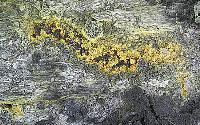 |
|
Unnamed skylight in the Kamoamoa lava tube just below 2300 feet. Ghostly figures in background are conducting VLF survey of tube to enable calculation of lava flux. |
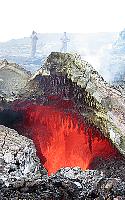 |
| Maps of lava-flow field, Kilauea Volcano |
Map shows lava flows erupted during the 1983-present activity of Pu`u `O`o and Kupaianaha (see large map). The flows active from December 17, 2000 through November 13, 2001 are shown in red; the active Kamoamoa flow is the westernmost red flow descending Pulama pali and entering the ocean at Kamoamoa. Lava is also pouring into the sea at the long-lasting East Kupapa`u entry and at a relatively new entry, Kupapa`u, 600 m farther southwest.
Most of the recent flows are fed from breakout points at 1920-1700 feet, above Pulama pali in the northern part of the large red area. Lava re-entered the sea near Kamokuna (just east of Kamoamoa) on January 21, 2001, but soon stopped when activity shifted from the western to the eastern branch of the flow. Since then, activity has been divided between the eastern and western branches. Breakouts from the eastern tube system have destroyed hundreds of meters of the Royal Gardens access road.
Lava has been entering the ocean and building a large bench at East Kupapa`u since April 25. A tiny trickle of lava fed through the western tube system dripped into the water just east of Kamoamoa on May 31 but stopped within a day. Thereafter, all lava leaving the island went through the East Kupapa`u entry until September 28-29, when the entry at Kamoamoa started. Yet a third ocean entry began on October 29, near the old Kupapa`u point, 600 m southwest of East Kupapa`u.
The URL of this page is http://hvo.wr.usgs.gov/kilauea/update/archive/2000/Nov/1-16.htmlContact: hvowebmaster@usgs.gov
Updated: 21 December 2001 (srb)
